Potrebujeme váš súhlas na využitie jednotlivých dát, aby sa vám okrem iného mohli ukazovať informácie týkajúce sa vašich záujmov. Súhlas udelíte kliknutím na tlačidlo „OK“.
ASTM E1021-15
Standard Test Method for Spectral Responsivity Measurements of Photovoltaic Devices
Automaticky preložený názov:
Štandardná skúšobná metóda pre spektrálnu responsivity Meranie fotovoltaických zariadení
NORMA vydaná dňa 1.2.2015
Informácie o norme:
Označenie normy: ASTM E1021-15
Poznámka: NEPLATNÁ
Dátum vydania normy: 1.2.2015
Kód tovaru: NS-585755
Počet strán: 11
Približná hmotnosť: 33 g (0.07 libier)
Krajina: Americká technická norma
Kategória: Technické normy ASTM
Kategórie - podobné normy:
Anotácia textu normy ASTM E1021-15 :
Keywords:
cell, irradiance, measurement, photovoltaic, quantum efficiency, radiant power, responsivity, solar, spectral, testing ,, ICS Number Code 27.160 (Solar energy engineering)
Doplňujúce informácie
| Significance and Use | ||||||||||||||||||||
|
5.1 The spectral responsivity of a photovoltaic device is necessary for computing spectral mismatch parameter (see Test Method E973). Spectral mismatch is used in Test Method E948 to measure the performance of photovoltaic cells in simulated sunlight, in Test Methods E1036 to measure the performance of photovoltaic modules and arrays, in Test Method E1125 to calibrate photovoltaic primary reference cells using a tabular spectrum, and in Test Method E1362 to calibrate photovoltaic secondary reference cells. The spectral mismatch parameter can be computed using absolute or relative spectral responsivity data. 5.2 This test method measures the differential spectral responsivity of a photovoltaic device. The procedure requires the use of white-light bias to enable the user to evaluate the dependence of the differential spectral responsivity on the intensity of light reaching the device. When such dependence exists, the overall spectral responsivity should be equivalent to the differential spectral responsivity at a light bias level somewhere between zero and the intended operating conditions of the device. Depending on the linearity response of the DUT over the intensity range up to the intended operating conditions, it may not be necessary to set up a very high light bias level. 5.3 The spectral responsivity of a photovoltaic device is useful for understanding device performance and material characteristics. 5.4 The procedure described herein is appropriate for use in either research and development applications or in product quality control by manufacturers. 5.5 The reference photodetector’s calibration must be traceable to SI units through a National Institute of Standards and Technology (NIST) spectral responsivity scale or other relevant radiometric scale.3 ,5.6 This test method does not address issues of sample stability. 5.7 Using results obtained by this test method and additional measurements including reflectance versus wavelength, one can compute the internal quantum efficiency of a device. These measurements are beyond the scope of this test method. 5.8 This test method is intended for use with a single-junction photovoltaic cell. It can also be used to measure the spectral responsivity of a single junction within a series-connected, multiple-junction photovoltaic device if electrical contact can be made to the individual junction(s) of interest. 5.9 With additional procedures (see Test Methods E2236), one can determine the spectral responsivity of individual junctions within series-connected, multiple-junction, photovoltaic devices when electrical contact can only be made to the entire device’s two terminals. 5.10 Using forward biasing techniques1.1 This test method is to be used to determine either the absolute or relative spectral responsivity response of a single-junction photovoltaic device. 1.2 Because quantum efficiency is directly related to spectral responsivity, this test method may be used to determine the quantum efficiency of a single-junction photovoltaic device (see 10.10). 1.3 This test method requires the use of a bias light. 1.4 The values stated in SI units are to be regarded as standard. No other units of measurement are included in this standard. 1.5 This standard does not purport to address all of the safety concerns, if any, associated with its use. It is the responsibility of the user of this standard to establish appropriate safety and health practices and determine the applicability of regulatory limitations prior to use. |
||||||||||||||||||||
| 2. Referenced Documents | ||||||||||||||||||||
|
Podobné normy:
Historická
1.6.2010
Historická
1.6.2010
Historická
1.11.2013
Historická
1.2.2015
Historická
1.3.2012
Historická
1.6.2010


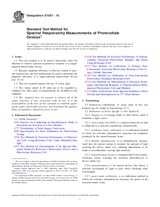
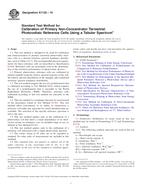 ASTM E1125-10
ASTM E1125-10 ASTM E1143-05(2010)..
ASTM E1143-05(2010)..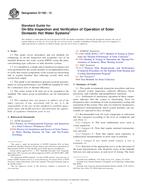 ASTM E1160-13
ASTM E1160-13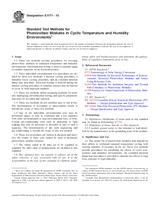 ASTM E1171-15
ASTM E1171-15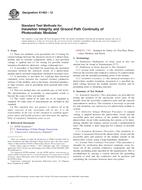 ASTM E1462-12
ASTM E1462-12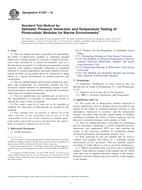 ASTM E1597-10
ASTM E1597-10
 Cookies
Cookies
